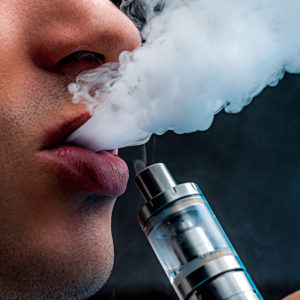The U.S. Food and Drug Administration is responsible for the regulation of tobacco and nicotine products. As a part of its purview of enforcement, the FDA has a statutory responsibility to prevent youth initiation of tobacco products like cigarettes and vapes.
While the mission is noble and has some success, the hard truth that remains centers on the uncanny ability of minors to access age-restricted products. Older teenagers (late high school, early college), for instance, are more likely to engage in what some would consider age-inappropriate activities that carry certain associated personal health risks with them. These activities include, naturally, the use of tobacco or nicotine, using marijuana, underage drinking and sexual activity.
As it pertains to the FDA’s role in preventing youth from tobacco use, the agency has received wide-ranging praise from the public health world for its “The Real Cost” campaign, which was started in 2014. Ever since then, the FDA’s Center for Tobacco Products has led the implementation of the campaign’s messaging and audience targeting focused on preteens and teens age 12 to 17 years.
Notoriously, “The Real Cost” has leaned heavily on the use of fear-mongering and stigma related to the use of cigarettes and other tobacco products. Through television advertisement campaigns and an active multi-channel digital marketing presence, the results of these scare tactics have yielded noticeable successes in getting minors to quit smoking through abstinence.
The campaign has focused heavily on cigarettes and actual tobacco-containing products; however, the FDA began an e-cigarette use prevention campaign targeted at the same age group after the agency declared that vaping among youth was endemic.
The FDA released disturbing depictions of what vaping could do to a teenager’s body. Whether it was the claim that all vaping liquid contains carcinogens or how the ads depict nicotine’s interaction with a developing brain, fear was easily stoked, leaving minors with only one view of what vaping is and why it exists.
Another round of ads, released this summer, was less fear-inducing. These “Real Cost” ads featured street magician Julius Dein doing “magic tricks” for random teens and bystanders. One ad depicts a group of youths surrounding Dein as he questioned an unnamed member of the group over his vaping habits. Dein then asks him to pull out his vape and place it in his hand. At the flick of his wrist, Dein causes the vape “magically” to become a cigarette, astonishing the unnamed vaper.
“It’s not magic. It’s statistics,” Dein says, as he told the group of astonished bystanders that vaping could lead to cigarette use.
While this set of TV spots don’t feature frightening imagery, they still offer scare tactics through a one-sided, negative depiction of vaping. Mostly, all of the advertisements ran under the “Real Cost” e-cigarette use prevention program offer cherry-picked data and research findings to advance the mission of fear to fight the youth vaping epidemic.
Moreover, to no surprise, these campaigns correspond with the typical forms of stigma and fear-mongering public health authorities have previously employed to protect health in some capacity.
For nicotine, it is almost always portrayed negatively. While commonly associated with the most obvious culprits being cigarettes and big tobacco, the drug itself is nothing more than a psychoactive substance that emulates caffeine.
The Royal Society for Public Health released a position statement in 2015, calling on those involved in the public debate about nicotine in the United Kingdom to remember the difference between the actual drug and tobacco.
“Getting people onto nicotine rather than using tobacco would make a big difference to the public’s health — clearly there are issues in terms of having smokers addicted to nicotine, but this would move us on from having a serious and costly public health issue from smoking-related disease to instead address the issue of addiction to a substance which in and of itself is not too dissimilar to caffeine addiction,” society chief executive Shirley Cramer said in a statement at the time.
Compared to nicotine, caffeine shares several characteristics. Both drugs promote improved cognition, vigilance and offers energy. Both drugs additionally offer negative impacts on health that include but not limited to addictive dependence, insomnia, increased blood pressure, and risks to overdose.
On this basis, the health effects of both nicotine and caffeine share similarities. Granted, nicotine and caffeine are neither equals in full health impacts but share many characteristics. Even though such similarities are shared, caffeine is not stigmatized and is often associated with the typical “delivery methods” of soda, coffee, energy drinks and many workout supplements.
However, members of the general public still view nicotine with a perception that it is deadly, cancer-causing and sinful. Much of this sentiment is owed to the stigmatization campaigns public health groups have used for years to communicate the health harms of tobacco smoke.
Lynn T. Kozlowski, the professor of community health and health behavior at University of Buffalo’s School of Public Health and Health Professions, has studied the dissemination of nicotine risk information in the United States for some time.
“It is more like propaganda than the transmission of evidence-based health information,” Kozlowski said in an email, alluding to the “magic trick” TV spots. “If a manufacturer were to make as preposterous a claim based on a small increase in confounded probabilities — that vaping in effect becomes smoking and that’s the ‘statistics’ — it would be considered a deceptive ad.”
Kozlowski, of course, points to the argument that vaping is a “gateway” for youth to start smoking combustible cigarettes. This claim is pushed often in the TV spots, offering an assessment that is biased, misinformed and institutionally harmful.
The gateway drug theory, or the progression hypothesis, is a theory that suggests that first-time use of a psychoactive substance will become a trend. If you think of the “Reefer Madness” argument about first-time marijuana use, the gateway argument, in the case of youth vaping, suggests that youth who begin nicotine uptake through vaping will progress to using riskier nicotine delivery methods like cigarettes.
While the gateway theory is disputed, evidence can be taken from other assessments of how these catalytic use arguments correspond to youth update of psychoactive substances. Notably, Deborah S Hasin et al. published findings in The Lancet to a 2016 study that found that medical marijuana legalization did not result in increased teen use of marijuana.
Drug Policy Alliance released a position statement in 2017, also, arguing that the theory as it relates to marijuana has flaws.
“The gateway theory falls victim to the mistaken assumption that correlation alone implies causation,” the DPA argued. “Using the same logic, one could argue that drinking milk is a gateway to illicit drug use since most people who use illicit drugs also drank milk as young people. The correlation between marijuana use and the use of other drugs should not be equated with causation.”
The gateway theory has also been used extensively in drug-control campaigns offering disputed claims as facts. Applying Kozlowski’s logic, this is precisely the case with the “Real Cost” campaign and how nicotine use is depicted to its young audience.
Kozlowski wrote a commentary for the academic journal Nicotine & Tobacco Research earlier this year arguing this point more eloquently. In this commentary, Kozlowski compares a youth’s right to harm reduction information as it pertains to sexual health versus how relative risk information is disseminated for tobacco products and nicotine.
“Respecting a right to accurate information for those who are using such products is far from the only influence on the use of such products,” he wrote. “Comparative-harm information on tobacco and/or nicotine products is only one factor affecting engagement in an activity.”
The “Real Cost” campaigns, in this case, offer very little comparative-harm information about vaping versus smoking. For example, Public Health England is oft-cited for determining that e-cigarettes are 95 percent safer than cigarettes after a comprehensive evidence review. Yet, this statistic was not featured in any of the “Real Cost” TV spots.
Raymond Niaura, a professor of social and behavioral sciences at New York University’s College of Global Public Health, has been one of the leading voices that detest the assumption that there is a gateway effect propagating a youth vaping public health epidemic.
Niaura recently testified before he Economic and Consumer Policy Subcommittee under the House Committee on Oversight and Reform during the controversial Juul Labs hearings. In his submitted written testimony, he argued that “most adolescent vaping was occasional and that most regular use was concentrated in adolescents who had already been smokers” and “most of the increase in vaping, therefore, was seen in youth who were already using other tobacco products.”
Niaura’s assessment offers a skeptical one versus what is argued throughout the “Real Cost” e-cigarette prevention TV spots. Nonetheless, the data explained in these ads still do a disservice in stigmatizing an act that is possibly one of the safest forms of nicotine delivery ever introduced into the market.
“The tendency of people who try things to try other things is well established,” writes David Sweanor in an email. Sweanor is an adjunct professor of law at the University of Ottawa Centre for Health Law, Policy and Ethics.
“If the FDA is truly worried about vapers turning to smoking they could greatly reduce that possibility through accurate communication of relative risks and risk-proportionate regulations,” he added. “Hyping risks, stigmatizing rather than empowering, misleading rather than informing. We see the FDA and other government agencies engaging in public health malpractice.”
It so happens that Kozlowski and Sweanor coauthored commentary arguing many of their points.
Both of them wrote for the International Journal of Drug Policy in 2016 that there are ethical justifications that public health organizations, like the FDA, should consider when disseminating pertinent risk information related to the benefits and risks of nicotine use.
I, with the those mentioned or interviewed, stand to believe that one of the most reliable tools in the tobacco harm reduction toolbox is accurate information. As demonstrated in the latest round of “Real Cost” ads, the efforts of public health organizations, at least in the United States, proves problematic. This is especially the case as it pertains to the rights of youth.


